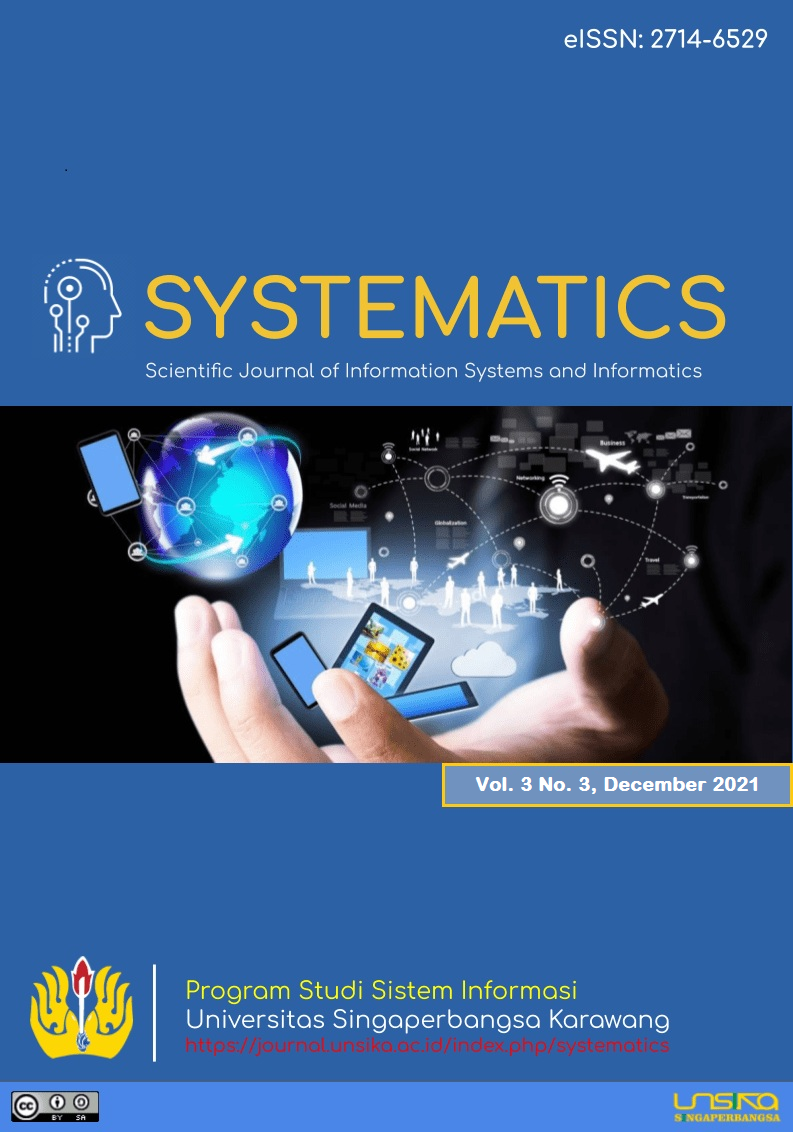Academic Information System Design Blockchain Based College
Desain Sistem Informasi Akademik Perguruan Tinggi Berbasis Blockchain
DOI:
https://doi.org/10.35706/sys.v3i3.5952Abstract
Academic Information System (SIAKAD) is an application designed for data management purposes so
that the entire process of academic activities can be managed into useful information. This data is
stored in a database, this causes problems, namely the difficulty of backing up data in case of damage
and difficulty when validating data because there is no verifier when inputting data, one of the data
stored is student transcripts, as we know that transcripts This student score can be used for scholarship
requirements and applying for jobs so that the transcript must be authenticated. Therefore, the purpose
of this research is to design a blockchain-based SIAKAD application that can make it easier to check
data validation to prove the authenticity of student grade transcripts and display traceability of student
grade data. Blockchain technology is a ledger that will record all activities carried out then the data
will be distributed to each node that has been determined and already has a certificate authority to
access the blockchain, then each node will have a copy of each transaction, each transaction will be
interrelated with the transaction next. The transactions made are student value data, the data will be
stored into the blockchain. In this study, a blockchain-based academic information system application
has been designed using the prototyping method and then using the hyperledger fabric as a framework
for building blockchain. The result of this research is a blockchain information system application that
can verify the authenticity of grade transcripts and see traceability of student grade data.
Downloads
References
S Santoso, “Seri Solusi Bisnis Berbasis TI: Total Quality Management and Six Sigma,” Elex Media Komputindo, 2017.
R. A. Dwi, “Pengaruh Penerapan Sistem Informasi Akademik Terhadap Kualitas Layanan Akademik Mahasiswa Di Fakultas Ilmu Sosial Dan Ilmu Politik Universitas Diponegoro. Fakultas Ilmu Budaya,” Universitas Diponegoro Semarang, 2012.
S. R. Yayu, ”Analisis Pengaruh Kualitas Sistem Informasi Akademik (Siakad) Terhadap Kepuasan Mahasiswa Sttkd Yogyakarta,” Conference on Innovation and Application of Science and Technology (CIASTECH 2019), 2019.
S. Bogart, R. Kerry, “The Blockchain Report: Welcome to the Internet of Value,” 2015.
X. Mingliang, L. Pei, L. Mingyuan, F. Hao, Z. Hongling, Z. Bing,
L. Yusong, Z. Liwei, “Medical Image Denoising by Parallel Non-Local Means.Neurocomputing,” 195:117-122, 2016.
X. Junxiao, Y. Hui, L. Pei, X. Mingliang, L. Yafei, “Crowd Queuing
Simulation with An Improved Emotional Contagion Model,” Science China:
Information Sciences, 62(4): 44101:1-44101:3, 2019.
U. Mukhopadhyay, A. Skjellum, O. Hambolu, J. Oakley, L. Yu, RAB. Brooks, “Survey of cryptocurrency systems,” InPrivacy, Security and Trust (PST), 2016.
D. Zhaoyang, L. Fengji, L. Gaoqi, “Blockchain: a secure, decentralized, trusted cyberinfrastructure solution for future energy systems,” Vol 6 (5), Journal of Mod. Power Syst. Clean Energy, 2018, pp. 958–967.
F. H. Dwi, “Perancangan Dan Implementasi Teknologi Blockchain Pada Sistem Pencatatan Hasil Rekapitulasi Pemilu Berdasarkan Formulir C1 Pindaian KPU,” Institut Teknologi Bandung, 2019.
Y. Xinyi, Z. Yi, Y. He, “Technical Characteristics and Model of Blockchain,” In2018 10th International Conference on Communication Software and Networks (ICCSN) IEEE, 2018, pp. 562-566.
K. Palanivel, “Blockchain Architecture to Higher Education Systems,” 2019.
J Simarmata, “Rekayasa Perangkat Lunak,” Yogyakarta: C.V Andi Offset, 2010.
Downloads
Published
How to Cite
Issue
Section
License
Copyright (c) 2021 SYSTEMATICS

This work is licensed under a Creative Commons Attribution-ShareAlike 4.0 International License.
Authors who publish with this journal agree to the following terms:
- Authors retain copyright and grant the journal right of first publication with the work simultaneously licensed under a Creative Commons Attribution-ShareAlike 4.0 International License. that allows others to share the work with an acknowledgement of the work's authorship and initial publication in this journal.
- Authors are able to enter into separate, additional contractual arrangements for the non-exclusive distribution of the journal's published version of the work (e.g., post it to an institutional repository or publish it in a book), with an acknowledgement of its initial publication in this journal.
- Authors are permitted and encouraged to post their work online (e.g., in institutional repositories or on their website) prior to and during the submission process, as it can lead to productive exchanges, as well as earlier and greater citation of published work (See The Effect of Open Access).







